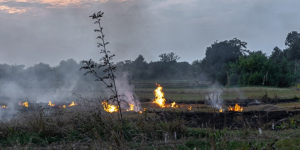The project will use satellite, meteorological, topographic and human activity information to identify and predict points with the highest risk, delivering weekly reports as well as future projections that allow anticipating and making better decisions.
Communications UA.- Chile suffered in 2023 the worst forest fires in decades, with at least 24 deaths and 100,000 hectares burned in a wave of fires in the center-south of the country that puts on the table the discussion not only how to be able to respond, but also the need for prevention.
In this sense, monitoring and early detection of areas susceptible to fires are valuable elements in which new technologies have much to contribute. “In recent years, artificial intelligence (AI) methods, particularly deep learning, have come a long way due to the remarkable success -compared to traditional models- in prediction and classification processes in various areas of science” comments Dr. Patricia Möller, researcher at the Faculty of Engineering of the Autonomous University of Chile.
This also applies to the spatial identification of areas susceptible to forest fires, however, “to date in Chile no study has evaluated its effectiveness” complements the scientist who is part of a recently awarded project that proposes an AI-based model that Allow a fire surveillance and prevention system.
«The use of AI is key to achieving the objective of the project, it will allow training and validating models, specifically (convolutional neural networks) and LSTM (long-term memory). This in order to monitor and predict areas of greater susceptibility» details Dr. Patricia Möller.
It is expected to generate models robust enough to reach over 90% efficiency, said efficiency will increase as more data is considered. The factors that are currently measured are the cover and density of the vegetal surface; amount of vegetation, vigor and green cover; the moisture content of stressed vegetation; the temperature of the earth’s surface; wind speed and direction; variation of surface heat; and the various uses that are given to the land among other relevant elements.
In this context, technology can be a great support resource, specifically AI, which has been very present lately, making it possible to develop models that can have very relevant public utilities. It should be noted that all the models created in this project will be hosted on a web platform, so that they can be openly consulted by the different entities of the community.
interuniversity collaboration
The project System for monitoring, detection and prediction of areas susceptible to forest fires through artificial intelligence It is one of the two awarded by the Autonomous University of Chile in the Interuniversity Fund for Initiation in Associative Research of the Interuniversity Network.
Contest whose purpose is to promote the joint development of initiation projects in associative research through a seed fund, through universities that are part of the Interuniversity Network.
The funds aim to stimulate the collaboration of complementary capacities between different houses of study to increase scientific research, promoting inquiry, experimentation, the development of new knowledge and innovation.
The winning project involves three large areas of work: forestry experience in fire; creation of predictive models using artificial intelligence; and creation of applications on digital platforms.
In this sense, Dr. César Marín from the Santo Tomás University contributes experience in research related to forest fires in Chilean Mediterranean forests, “being the one who provides an ecological point of view of the forest, a look on the ground of the different areas that can present susceptibility to fires» as reported by Dr. Patricia Möller.
On the other hand, doctors Patricia Möller from the Autonomous University of Chile and Carlos Maldonado from the Universidad Mayor, will contribute with their knowledge and experience in modeling through the use of artificial intelligence and data mining techniques, among which is included the development and implementation of neural network techniques and Deep learning, using supervised and unsupervised modeling methods.
In addition, they will be in charge of supervising the implementation of the predictive system on the different digital platforms together with Dr. Inesmar Briceño from the Andrés Bello University. In particular, she will be the main person in charge of the implementation of digital platforms that house the predictive system, creation of an interactive and intuitive interface (considering that it will be used by different public and private entities), its enablement, and subsequent evaluation of constant availability. of the system.
The project also contemplates the training of undergraduate thesis students, the generation of a scientific publication, the dissemination of the project results in traditional and/or alternative media, as well as the presentation of the predictive model to the community.
«There is no doubt that AI is already part of the present, as is the increase in global temperature and climate change, which have generated and will continue to drive an increase in the frequency and magnitude of forest fires worldwide, including to our country» concludes the researcher from the Autonomous University of Chile.




![[Img #74675]](https://thelatestnews.world/wp-content/uploads/2024/12/They-discover-a-new-class-of-X-ray-sources-in-the-150x150.jpg)






![[Img #74675]](https://thelatestnews.world/wp-content/uploads/2024/12/They-discover-a-new-class-of-X-ray-sources-in-the-300x200.jpg)

